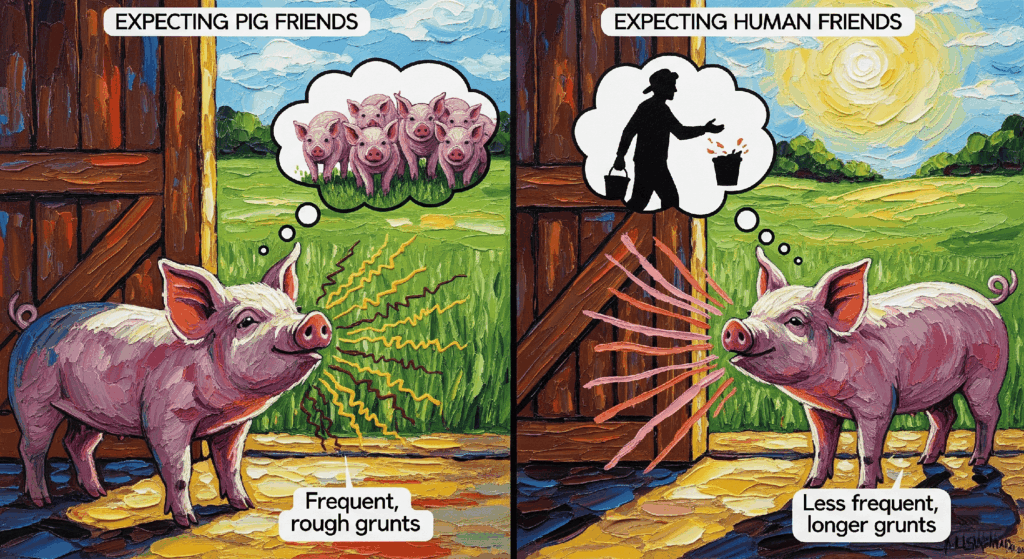What Pig Grunts Can Tell Us About Their Feelings
Picture a sunlit barn on a crisp morning, where a group of curious piglets gathers near the wooden fence. The soft rustling of hay and the gentle creaks of the barn are accompanied by a chorus of lively grunts. As they wait eagerly, these grunts are not mere sounds; they carry hidden emotional messages.
Scientists have discovered that piglets’ grunts reveal their excitement and expectations, offering us a window into their emotional lives.

The Science of Anticipation
When animals look forward to something pleasant – like meeting friends or getting a treat – they show “anticipatory behavior.” This behavior reveals how the animal feels about what’s coming. While researchers have studied body movements during anticipation in many animals, few have analyzed the sounds animals make while waiting.
That’s where this groundbreaking pig study comes in. Researchers wanted to know if piglets make different sounds when expecting different pleasant social interactions, and whether these sounds could reveal their emotional state.
How They Studied Pig Emotions
The research team worked with 60 female piglets. They created two groups:
- One group had minimal human contact (just routine care)
- The other group received additional gentle interactions with humans (like being petted and spoken to)
They then trained the piglets to recognize specific signals (lights and sounds) that indicated either:
- Their piglet friends would soon enter the room
- A familiar human would soon enter the room
In the final test, researchers delayed the arrival of the expected visitor after showing the signal. This allowed them to observe how the piglets responded when their expectations weren’t immediately met.
What They Found: Behavior Shows Preferences
When piglets saw signals that their friends were coming, they:
- Positioned themselves near the door where friends would enter
- Maintained this position even when arrival was delayed
- Showed more intense anticipation compared to when expecting humans
This behavior pattern suggests piglets prefer being with other pigs instead of humans, which makes sense for such social animals. Still, the most interesting discoveries came from studying the sounds they made.
The Secret Language of Grunts
The researchers recorded and analyzed thousands of piglet grunts, examining both how frequently they grunted and the acoustic properties of each sound. They discovered:
When expecting pig friends:
- Piglets grunted more frequently (shorter time between grunts)
- Their grunts contained more spectral noise, which means the sounds were more jumbled or harsh-sounding compared to purer tones.
- When friends’ arrival was delayed, grunt duration increased
When expecting human friends:
- Piglets grunted less frequently
- Their grunts had longer duration and wider frequency range
- When human arrival was delayed, spectral parameters changed to resemble isolation sounds
These differences suggest piglets experience different emotional states when anticipating different social partners.
Why Grunt Length Matters
The study found that grunt duration increased when expectations were violated – when piglets waited longer than expected for their friends or humans. This aligns with previous research showing that longer grunts often indicate negative emotions in pigs.
Importantly, piglets that had received extra human contact showed different vocal patterns when expecting humans compared to those with minimal human interaction, suggesting their relationship history affected their emotional response.
Beyond What We Can See
What makes this study remarkable is that vocal analysis revealed emotional nuances that weren’t apparent from watching behavior alone. While both groups of piglets showed anticipatory behavior, their vocal expressions provided deeper insight into their emotional states.
As the researchers noted: “Vocal expression (time and spectral features) is thus a good way to explore the emotional state of piglets during anticipation of challenging events.”
Why This Matters
Understanding animal emotions isn’t just scientifically interesting – it has practical applications for animal welfare. If we can better recognize how animals communicate their feelings, we can:
- Improve living conditions for farm animals
- Better assess animal welfare in various settings
- Develop more accurate ways to measure positive emotions in animals, not just negative ones
The Bigger Picture
This research adds to the growing evidence that animals have rich emotional lives. They use many signals to communicate, including sounds that people might not notice or understand without scientific help.
For pig farmers and animal welfare experts, these findings offer a new tool: listening carefully to pig vocalizations might help them better understand pig emotions and improve their care accordingly.
For everyone else, this is a reminder that animal communication is complex and meaningful, even if it just sounds like grunting to us. Next time you’re near a farm, pause and listen – listen closely to the symphony of grunts and consider what emotions might be flowing through those pigs. Remember, they might be sharing more than we think.
Leave a Reply